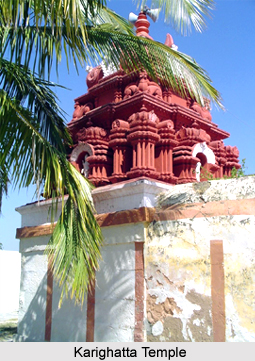 Karighatta Temple, located atop the enchanting Karighatta hill, is positioned at a height of 2697mts feet above sea level. The Karighatta hill, meaning `Black Hill` in Kannada is few kilometres away outside the Srirangapatna Island, offering captivating view of Srirangapatna and Mysore. The temple, located off the Bangalore-Mysore Highway, boasts of housing a black idol of Srinivasa or Lord Vishnu. The deity is also named as Karigirivasa and Bairagi Venkataramana. It has derived the epithet `Bairagi` for the reason that when it is decked with flowers it appears as a Bairagi i.e. mendicant.
Karighatta Temple, located atop the enchanting Karighatta hill, is positioned at a height of 2697mts feet above sea level. The Karighatta hill, meaning `Black Hill` in Kannada is few kilometres away outside the Srirangapatna Island, offering captivating view of Srirangapatna and Mysore. The temple, located off the Bangalore-Mysore Highway, boasts of housing a black idol of Srinivasa or Lord Vishnu. The deity is also named as Karigirivasa and Bairagi Venkataramana. It has derived the epithet `Bairagi` for the reason that when it is decked with flowers it appears as a Bairagi i.e. mendicant.
Architecture of Karighatta Temple
Karighatta Temple, housing the 6 feet tall idol of Lord Srinivasa, is set in the midst of a dry scrub forest surrounded by tamarind and gooseberry trees. Lokapavani, a tributary of Kaveri River, flows by the side of the temple, casting an imposing view for the pilgrims and adventure seekers frequenting the temple.
The chief entrance door of the temple, made of wood, welcomes the devotees into a huge quadrangle enshrined with the idol of Vaikunta Srinivasa flanked by images of Bhoga Srinivasa and Yoga Srinivasa. The idol of Goddess Padmavati has been installed on the western side. A statue of Garuda and the stone footprint of Lord Vishnu are also installed in the vicinity of the temple. As per historical records, sage Bhrigu is said to have installed the deities of the temple. The pilgrimage centre also has a Kalyana Mantapa (marriage hall) used for performing marriages and other ceremonies.
Legend of Karighatta Temple
The temple finds its mention in Varaha Purana as `Neelachala.` It is a Sanskrit word which means `Blue Mountain.` It is a common belief among the devotees that by offering poojas and worshipping the deity, the sufferings of live depart. According to a legend the temple got its name from a wild elephant, Kari, said to have killed four girls. Sage Kutsamuni undertook severe penances to restore back life in them. As per another legend in Ramayana, Sugreeva had brought this hillock for building a bridge to Lanka for rescuing Sita. Later the disciples of Lord Vishnu requested them to keep the mountain there.
The temple premise has sharp grasses, Eragrostis cynosuroides, also known as Dharbe hullu. These are usually used during sacred rituals. Varaha Purana mentions that when Vishnu took the form of Varaha, he shook his body here. The hair that fell from his body in this region developed into these grasses.
Festivals of Karighatta Temple
Karighatta Temple celebrates the car festival every year with great vigour. The festival, thought to have been initiated by the sage Vaikhanasa in the Treta Yuga, is celebrated during the months of February and March. During the festival an annual fair is also organised, attracting pilgrims from different corners of the country.
Karighatta Temple is well connected by different modes of transport. The Karighatta hill can be reached climbing the stone steps that leads to a flat hilltop. The temple, located on the confluence of the Kaveri River and Lokapavani River, draws the attention of many pilgrims. Devotees can avail buses provided by Karnataka State Road Transport Corporation. Mysore domestic airport is the nearest air terminal, located at a distance of 14 kms away from Srirangapatnam. Bangalore is the nearest international airport which is at a distance of 140 kms away from Mysore. Mysore railway station is the nearest railhead to Srirangapatna.





















